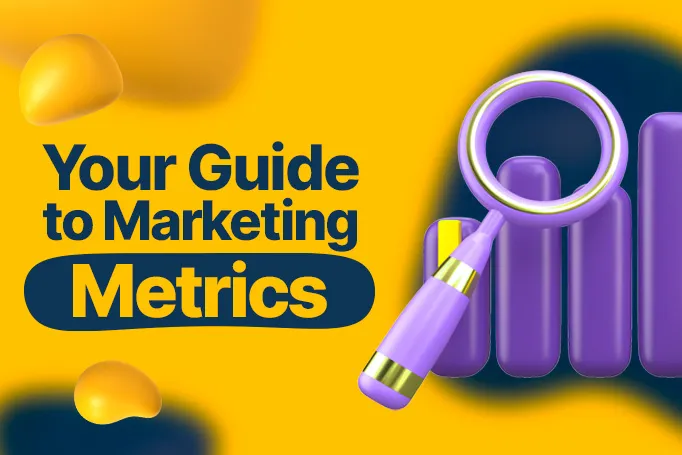Modern marketing is a tricky subject, and it can be difficult to gauge whether or not key aspects of your digital strategies are performing up to par.
This is why marketing metrics and Key Performance Indicators (KPIs) act as guides to marketers everywhere, giving them insight into how well their campaigns are performing and measuring the impact of their overall strategies.
That is, if those marketers know the right metrics and KPIs to watch.
In the overwhelming sea of data that’s available, knowing the right metrics to track can be a challenge.
So, if you're looking for a compass to help you navigate the world of marketing metrics, then today is your lucky day! Today’s blog is your guide to marketing metrics, the KPIs you should be watching, and how to use them to steer your brand toward success!
What are Marketing Metrics?
Marketing metrics are measurable values used to assess the performance of a variety of marketing activities and campaigns.
They provide insight into how well your marketing efforts are going and are crucial in helping you evaluate your overall ROI. They can cover a wide range of KPIs to help you analyze different aspects of your efforts and how well your strategies are working.
Why Do Marketing Metrics Matter?

Your marketing metrics make it possible to evaluate the performance of all of your marketing campaigns and provide the measurable insights and tangible evidence needed to support data-driven decision-making.
They can also help your brand with the following:
- Goal Alignment — Metrics help align marketing activities with overall business goals. By tracking specific key performance indicators (KPIs), marketers can make sure that their efforts contribute directly to the achievement of broader organizational objectives.
- Resource Optimization — Metrics allow marketers to optimize resource allocation by identifying which channels, campaigns, or tactics are generating the best return on investment. This helps in allocating budget and manpower more effectively.
- Continuous Improvement — Regular monitoring of metrics facilitates a culture of continuous improvement. Marketers can identify areas for enhancement, refine strategies, and iterate on campaigns to achieve better results over time.
- Accountability and Transparency — Metrics provide a transparent way to measure marketing ROI and demonstrate the impact of marketing activities on stakeholders. This accountability is essential for securing and maintaining support and resources for marketing initiatives.
- Customer Insights — Marketing metrics often reflect customer behavior and preferences. Understanding these insights allows marketers to tailor strategies to meet customer needs, improving the overall customer experience.
- Competitive Benchmarking — Metrics enable marketers to benchmark their performance against competitors. Understanding how your metrics compare to industry standards helps in identifying areas where your marketing can outperform or where improvements are needed.
- Adaptation to Market Changes — In a dynamic market, metrics provide early indicators of changes in consumer behavior or market trends. Marketers can adapt their strategies quickly to stay ahead of the competition and meet evolving customer needs.
- Demonstration of Value — Marketers can use metrics to showcase the value of their efforts to upper management or clients. Clear metrics help build trust by illustrating the impact of marketing activities on business outcomes.
- Efficient Marketing Budgeting — Metrics help in allocating marketing budgets more efficiently by identifying high-performing channels or campaigns. This ensures that resources are invested where they are most likely to yield positive results.
Choosing the Right KPIs
It’s important that you choose the right KPIs when monitoring your metrics.
Choosing the right KPIs will make sure that your digital marketing efforts are aligning with your goals and providing you with the accurate insight you need for decision-making and strategy.
Here's a step-by-step guide on how to choose the right KPIs for your brand.
- Clearly Define Your Goals — Begin by clearly defining your overall business objectives. Understand what you want to achieve in terms of sales, brand awareness, customer retention, or any other specific goal.
- Identify Key Business Metrics — Align your KPIs with key business metrics that directly impact your goals. For example, if your goal is to increase revenue, relevant KPIs might include conversion rate, average order value, and customer acquisition cost.
- Understand Your Audience — Consider your target audience and their behavior. If you're focused on customer engagement, social media metrics like likes, shares, and comments might be relevant. For customer acquisition, metrics like cost per lead (CPL) or cost per acquisition could be important.
- Consider the Customer Journey — Map out the customer journey and identify critical touchpoints. Choose KPIs that correspond to each stage of the customer journey, from awareness and consideration to conversion and retention.
- Ensure Measurability — Select KPIs that are measurable and quantifiable. Ensure that you have access to the necessary data to track and analyze these metrics effectively.
- Prioritize Relevance — Prioritize relevance over volume. It's better to focus on a few key metrics that directly impact your goals rather than tracking a large number of metrics that may not provide actionable insights.
- Use the SMART Criteria — Your chosen KPIs should meet the SMART criteria: Specific: Clearly define what you're measuring. Measurable: Use quantifiable metrics. Achievable: Ensure that the KPIs are realistic and attainable. Relevant: Align with your business objectives. Time-bound: Set a timeframe for achieving or assessing the KPI.
- Regularly Review and Adjust — Periodically review your KPIs to ensure they remain aligned with your business goals. As your business evolves, you may need to adjust your KPIs accordingly.
- Seek Input from Stakeholders — Involve key stakeholders in the decision-making process. Gather input from your sales team, marketing team, and customer service department to ensure a holistic view of performance.
- Experiment and Learn — Be willing to experiment with different KPIs and learn from the results. If a particular metric isn't providing valuable insights, consider exploring alternative indicators.
Remember that the right KPIs will evolve as your business goals and strategies evolve. Regularly revisit and refine your KPIs to make sure that they remain effective in measuring and driving the goals you choose.
Key Marketing Metrics and KPIs Your Brand Should Be Watching
In no particular order, here are 10 of the most useful and insightful marketing metrics for your brand to watch to gain valuable insights into the effectiveness of your campaigns, better understand customer behavior, and make data-driven decisions for continual improvement!
1. Brand Awareness Metrics
Potential customers need to know your brand exists before you can start them on the path toward being loyal advocates of your brand! Because of this, brand awareness is a crucial aspect of a company's marketing strategy, and monitoring the right metrics can provide insights into its effectiveness!
Here are some key brand awareness metrics that a marketing team should watch:
- Social Media Mentions — Track mentions of your brand on social media platforms. This includes direct mentions, tags, and discussions related to your brand. KPI: Engagement rate.
- Brand Impressions — Measure the number of times your brand content is displayed, whether it's on social media, search engines, or other digital platforms. KPI: Impressions Growth
- Web Traffic Sources — Analyze the sources of your website traffic to see how many visitors come directly by typing your brand name into a search engine. KPI: Direct Traffic Percentage
- Search Engine Ranking — Monitor your brand's position in search engine results for relevant keywords. Higher rankings often correlate with increased visibility. KPI: Keyword Ranking
- Brand Sentiment — Assess the sentiment of online mentions to understand how people feel about your brand. Tools like sentiment analysis can help gauge positive, negative, or neutral sentiment. KPI: Sentiment Score
- Brand Recall — Conduct surveys or polls to measure how well your target audience remembers your brand. This can include unaided and aided recall questions. KPI: Recall Rate
- Share of Voice — Determine the percentage of brand mentions in your industry compared to competitors. A higher share of voice indicates greater brand visibility. KPI: Share of Voice Percentage
- Social Media Follower Growth — Track the growth in your social media followers. An increasing follower count suggests a growing audience familiar with your brand. KPI: Follower Growth Rate
- Branded Search Volume — Analyze the number of searches specifically for your brand name. Higher search volumes indicate increased brand curiosity or interest. KPI: Search Volume Trend
- Inbound Links — Measure the number and quality of inbound links to your website. Quality backlinks can contribute to higher visibility and credibility. KPI: Backlink Quality
2. Metrics for Content Marketing
Effective content marketing is not just about creating content; it's about creating high-quality content that resonates with your audience, hits their pain points, and drives meaningful interactions.
To see how well your content strategy is working, here are the key metrics to watch to keep your content impactful and connecting with your target audience!
- Content Engagement — Track the level of engagement with your content, including likes, comments, and shares on various platforms. KPI: Engagement Rate.
- Pageviews — Measure the number of views your content receives on your website or other platforms. KPI: Pageviews Growth.
- Conversion Rate — Evaluate how well your content converts visitors into leads or customers. Track actions such as form submissions, downloads, or purchases. KPI: Conversion Rate.
- Bounce Rate — Analyze the percentage of visitors who navigate away from your site after viewing only one page. A lower bounce rate indicates better content engagement. KPI: Bounce Rate Percentage.
- Time on Page — Assess the average amount of time visitors spend on a page. Longer durations may suggest that your content is captivating and holds audience interest. KPI: Average Time on Page.
- Content Reach — Determine the reach of your content by measuring the number of unique users exposed to it. KPI: Unique Users Reached.
- Social Shares — Keep tabs on how often your content is shared on social media platforms. This metric reflects the virality and social impact of your content. KPI: Social Share Count.
- Click-Through Rate (CTR) — Track the percentage of users who click on a link within your content. A higher CTR indicates effective call-to-action implementation. KPI: Click-Through Rate Percentage.
- Subscriber Growth — If you use content to drive subscriptions, monitor the growth in your subscriber base. KPI: Subscriber Growth Rate.
- Content Quality — Assess the overall quality of your content by considering factors like readability, relevance, and audience feedback. KPI: Content Quality Score.
3. Website Metrics

Your website.
It’s the digital hub for your brand. It contains information about your brand, your products or services, your team, and it’s a place your customers know they can go to contact you, learn about your offerings, or access the resources they need.
Because of this, it’s crucial to track its performance and user interactions. Here are the key website metrics to make sure that your online presence is both user-friendly, effective, and encouraging your prospects to convert:
- Traffic Volume — Monitor the overall number of visitors to your website over a specific period. KPI: Total Traffic Volume.
- Unique Visitors — Assess the number of distinct individuals who visit your site within a defined timeframe. KPI: Unique Visitor Count.
- Browsing Session Duration — Analyze how much time, on average, users spend on your website during a single session. Longer durations often indicate engaging content. KPI: Average Session Duration.
- Pages per Session — Track the average number of pages a visitor views in one session. Higher values suggest deeper exploration of your site. KPI: Pages per Session.
- Bounce Rate — Evaluate the percentage of visitors who leave your site after viewing only one page. A lower bounce rate generally indicates more engaging content. KPI: Bounce Rate Percentage.
- Conversion Rate — Measure the percentage of visitors who take a desired action, such as making a purchase or filling out a form. KPI: Conversion Rate.
- Click-Through Rate (CTR) — Assess the percentage of users who click on a specific link or call-to-action on your website. KPI: Click-Through Rate Percentage.
- Exit Pages — Identify the pages from which visitors most commonly exit your site. This helps pinpoint potential issues or areas for improvement. KPI: Exit Page Identification.
- Mobile Responsiveness — Ensure your website performs well on mobile devices by tracking the percentage of mobile users and assessing user experience. KPI: Mobile Responsiveness Score.
- Page Load Time — Monitor how quickly your web pages load, as faster load times contribute to a better user experience. KPI: Average Page Load Time.
4. Conversion Metrics
Conversions are the goal of your online marketing strategy. They represent the actions you want users to take on your website or other online resources. Because they’re so vital to your success, you’ll want to keep track of them using the right metrics.
Here are the metrics you should watch for to help you refine your strategies, optimize user journeys, and ultimately drive more meaningful actions from your website visitors.
- Conversion Rate — Measure the percentage of website visitors who complete a desired action, such as making a purchase, filling out a form, or signing up for a newsletter. KPI: Conversion Rate.
- Lead Generation — Track the number of leads generated through your website, indicating the effectiveness of your efforts in capturing potential customers' information. KPI: Leads Generated.
- Abandoned Cart Rate — Assess the percentage of users who add items to their shopping cart but leave the site without completing the purchase. Understanding this metric can help optimize the checkout process. KPI: Abandoned Cart Rate.
- Click-Through Rate (CTR) on CTAs — Analyze the percentage of users who click on specific calls-to-action (CTAs) across your website. This metric indicates the appeal and relevance of your CTAs. KPI: CTA Click-Through Rate.
- Cost per Conversion — Calculate the average cost incurred for each successful conversion. This metric is valuable in assessing the efficiency of your marketing spend in driving desired actions. KPI: Cost per Conversion.
- Conversion Funnel Drop-off Points — Identify stages in your conversion funnel where users commonly drop off without completing the desired action. Understanding these points helps optimize the user journey. KPI: Funnel Drop-off Percentage.
- Customer Acquisition Cost (CAC) — Determine the cost associated with acquiring a new customer through your website. This metric helps evaluate the overall efficiency of your customer acquisition efforts. KPI: Customer Acquisition Cost.
- Return on Investment (ROI) — Evaluate the return on investment for your conversion-related activities, providing insights into the profitability of your online efforts. KPI: ROI Percentage.
- Average Order Value (AOV) — Track the average value of orders placed on your website, providing insights into purchasing patterns and potential upselling opportunities. KPI: Average Order Value.
- Conversion Attribution — Understand which marketing channels and touchpoints contribute most to conversions. Attribution analysis helps allocate resources effectively. KPI: Attribution Weighting.
5. Social Media Metrics
Social media is a busy, busy place, and with all of the buzz around you, your metrics have to act as a compass to guide your online presence.
They can provide valuable insights into important factors such as social media engagement, content performance, and the overall impact of your social media strategies. So, to maximize your social media efforts, you need to be monitoring the right metrics.
Here's a breakdown of key social media metrics to help you refine your strategies and enhance your online presence:
- Engagement Rate — Gauge the level of interaction your content receives by measuring likes, comments, and shares. This metric reflects the effectiveness of your content in resonating with your audience. KPI: Engagement Rate.
- Follower Growth — Track the growth of your social media followers over time. A steady increase indicates the attractiveness and relevance of your content to a broader audience. KPI: Follower Growth Rate.
- Click-Through Rate (CTR) on Shared Links — Analyze the percentage of users who click on links shared on your social media channels. This metric provides insights into the appeal and relevance of your shared content. KPI: Link CTR.
- Conversion from Social Media — Measure the number of conversions directly attributed to social media channels. This helps evaluate the impact of your social media efforts on desired actions. KPI: Social Media Conversion Rate.
- Brand Mentions — Keep track of mentions of your brand on social media platforms. Monitoring brand mentions provides insights into brand visibility, sentiment, and engagement. KPI: Brand Mention Volume.
- Social Media Impressions — Assess the total number of times your content is displayed on users' screens. This metric reflects the reach and visibility of your social media content. KPI: Impressions Count.
- Post Reach — Measure the number of unique users who have seen your social media posts. Understanding your post reach is essential for evaluating the effectiveness of your content distribution. KPI: Post Reach Percentage.
- Social Media Ad Performance — Evaluate the effectiveness of your paid social media campaigns by analyzing metrics such as click-through rate, conversion rate, and cost per click. KPI: Ad Performance Score.
- Audience Demographics — Understand the demographics of your social media audience, including age, location, and interests. This information helps tailor content to better resonate with your target audience. KPI: Audience Demographic Insights.
- Social Listening Sentiment — Utilize social listening tools to gauge the sentiment surrounding your brand or industry on social media. Understanding sentiment helps in proactive reputation management. KPI: Sentiment Score.
6. Email Marketing Metrics
Email marketing campaigns can be extremely effective for your brand.
But in order to unlock its full potential, you’ll have to keep an eye on the key metrics that matter. The right metrics can provide valuable insights into subscriber engagement, content performance, and the overall impact of your email initiatives.
Make sure your email campaign is delivering the results you want by monitoring the following metrics:
- Open Rate — Measure the percentage of recipients who open your email. A high open rate indicates compelling subject lines and relevant content. KPI: Open Rate Percentage.
- Click-Through Rate (CTR) — Analyze the percentage of email recipients who clicked on one or more links contained in your email. CTR reflects the engagement level with your content. KPI: Email CTR.
- Conversion Rate — Track the percentage of email recipients who completed a desired action, such as making a purchase or signing up for an event. Conversion rate showcases the effectiveness of your email in driving actions. KPI: Conversion Rate.
- Bounce Rate — Measure the percentage of emails that were not delivered successfully to the recipient's inbox. A high bounce rate may indicate issues with email list quality or deliverability. KPI: Bounce Rate.
- List Growth Rate — Monitor the rate at which your email subscriber list is growing. A healthy growth rate signifies effective strategies in acquiring new subscribers. KPI: List Growth Rate.
- Email Sharing/Forwarding Rate — Track the number of times your email content is shared or forwarded by recipients. This metric gauges the viral potential of your emails. KPI: Sharing/Forwarding Rate.
- Unsubscribe Rate — Measure the percentage of subscribers who opt out or unsubscribe from your email list. Keeping this rate low is crucial for maintaining a healthy and engaged subscriber base. KPI: Unsubscribe Rate.
- Email Deliverability — Assess the ability of your emails to reach the recipients' inboxes. High deliverability ensures that your messages are reaching the intended audience. KPI: Deliverability Rate.
- Email Client Open Rate — Understand the distribution of open rates across various email clients. This insight is valuable for optimizing email design and compatibility. KPI: Top Email Clients.
- Time of Open — Analyze the times and days when your emails are most frequently opened. This information helps optimize the timing of future campaigns for maximum impact. KPI: Peak Open Times.
7. SEO Metrics
If you want potential customers to find your website, it’s got to be visible.
SEO metrics provide marketers with valuable insight into the performance of their websites, their visibility on search engines, and the impact of your SEO efforts in general.
Understanding and optimizing the following metrics are crucial to getting your site ranking higher and driving organic traffic:
- Organic Traffic — Gauge the volume of visitors coming to your website through organic search results. A steady increase in organic traffic indicates improved visibility on search engines. KPI: Organic Traffic Growth.
- Keyword Rankings — Track the rankings of your target keywords on search engine results pages (SERPs). Improved rankings signify enhanced visibility for terms relevant to your business. KPI: Top Keyword Rankings.
- Click-Through Rate (CTR) from Search Results — Analyze the percentage of users who click on your website's link when it appears in search results. A high CTR indicates compelling meta titles and descriptions. KPI: Search CTR.
- Backlink Profile — Assess the quantity and quality of backlinks pointing to your website. A strong backlink profile contributes to higher authority and improved search engine rankings. KPI: Backlink Quantity and Quality.
- Page Load Speed — Measure the time it takes for your web pages to load. Faster load times contribute to a positive user experience and can positively impact search rankings. KPI: Page Load Speed.
- Bounce Rate from Organic Search — Track the percentage of users who visit a single page on your site and then leave without interacting further. A high bounce rate may indicate issues with content relevance. KPI: Organic Bounce Rate.
- Pages Indexed — Monitor the number of pages from your website that search engines have crawled and indexed. A comprehensive indexation ensures a broader presence in search results. KPI: Indexed Pages.
- Mobile-Friendly Usability — Ensure that your website provides a seamless experience on mobile devices. Mobile-friendly websites are favored by search engines and contribute to improved rankings. KPI: Mobile Usability Score.
- Local SEO Metrics — If applicable, track metrics such as local search rankings, online reviews, and local business listings to enhance visibility for location-based searches. KPI: Local SEO Performance.
- Conversion from Organic Search — Measure the number of conversions directly attributed to organic search traffic. Understanding this metric helps evaluate the impact of SEO efforts on desired actions. KPI: Organic Conversion Rate.
8. Mobile Marketing Metrics

In today’s world, where everyone is attached to their smartphones, understanding the performance of your mobile marketing efforts is vital for connecting with on-the-go audiences.
The following mobile marketing metrics shed light on user engagement, app performance, and the overall effectiveness of your mobile strategies.
- App Downloads — Monitor the number of times your mobile app is downloaded. A growing number of downloads indicates increasing app visibility and user interest. KPI: App Downloads.
- App Install Conversion Rate — Measure the percentage of users who install your app after visiting the app store. A higher conversion rate indicates the effectiveness of your app store presence. KPI: Install Conversion Rate.
- In-App Engagement — Track user interactions within your mobile app, such as screen views, clicks, and time spent. In-depth engagement metrics reveal how users interact with your app's features. KPI: In-App Sessions.
- User Retention Rate — Analyze the percentage of users who continue to use your mobile app over time. High retention rates signify the app's ability to retain and engage its user base. KPI: User Retention Rate.
- Mobile Ad Performance — Evaluate the effectiveness of your mobile advertising campaigns, considering metrics like click-through rate (CTR), conversion rate, and cost per acquisition (CPA). KPI: Mobile Ad ROI.
- Mobile Website Traffic — Gauge the volume of visitors accessing your website via mobile devices. With mobile internet usage on the rise, optimizing for mobile traffic is crucial. KPI: Mobile Traffic Share.
- Push Notification Effectiveness — Measure the impact of push notifications on user engagement. Analyze metrics like open rates and click-through rates for push notifications. KPI: Push Notification Engagement.
- Mobile Conversion Rate — Track the percentage of users who complete desired actions on your mobile platform, such as making a purchase or filling out a form. KPI: Mobile Conversion Rate.
- Mobile Commerce Metrics — If applicable, monitor metrics related to mobile e-commerce, including mobile transaction volume, average order value, and cart abandonment rates. KPI: Mobile Sales Metrics.
- Location-Based Metrics — Use location-based metrics to understand how users engage with your brand based on their geographical location. This can inform targeted marketing strategies. KPI: Location-Based Engagement.
9. Customer Satisfaction Metrics
Brand loyalty and a stellar reputation start with customer satisfaction.
Because this is the heartbeat of your business and such an important metric, monitoring and understanding the satisfaction levels of your new and existing customers is key. Use the following metrics to provide actionable insights for enhancing products, services, and overall customer experience.
- Net Promoter Score (NPS) — Measure the likelihood of customers recommending your product or service. Calculate the NPS based on a scale of 0 to 10, classifying respondents as promoters, passives, or detractors. KPI: Net Promoter Score.
- Customer Satisfaction Score (CSAT) — Assess customers' overall satisfaction with a specific interaction, transaction, or experience. Typically measured on a scale, this metric provides insights into immediate satisfaction. KPI: Customer Satisfaction Score.
- Customer Effort Score (CES) — Evaluate the ease with which customers can achieve their goals when interacting with your product or service. Lower effort scores correlate with higher satisfaction. KPI: Customer Effort Score.
- Retention Rate — Track the percentage of customers who continue to do business with your company over a specific period. A high retention rate indicates ongoing satisfaction and loyalty. KPI: Customer Retention Rate.
- Churn Rate — Measure the percentage of customers who cease their relationship with your business within a given timeframe. A lower churn rate suggests higher customer satisfaction and loyalty. KPI: Churn Rate.
- Customer Feedback — Gather qualitative insights through direct customer feedback, reviews, and comments. Analyzing customer sentiments provides a deeper understanding of satisfaction drivers. KPI: Positive Feedback Percentage.
- Average Resolution Time — Assess the efficiency of your customer support by measuring the average time it takes to resolve customer issues. Swift resolutions contribute to positive satisfaction. KPI: Average Resolution Time.
- First Contact Resolution (FCR) — Measure the percentage of customer issues resolved during their initial contact with customer support. Higher FCR indicates effective and efficient problem-solving. KPI: First Contact Resolution Rate.
- Customer Lifetime Value (CLV) — Estimate the total revenue a business can expect from a customer over their entire relationship. Higher CLV often correlates with satisfied, repeat customers. KPI: Customer Lifetime Value.
- Social Media Sentiment — Monitor sentiment about your brand on social media platforms. Positive sentiment indicates customer satisfaction, while negative sentiment may highlight areas for improvement. KPI: Social Sentiment Score.
10. Financial Metrics
Financial metrics shed some light on the fiscal health and performance of your business.
Depending on the KPIs you’re monitoring, they can provide insight into important finance-related areas like revenue generation, profitability, and overall financial sustainability.
Keep an eye on the following metrics to keep your business thriving!
- Revenue Growth Rate — Measure the percentage increase in total revenue over a specific period. Positive revenue growth is indicative of a thriving business. KPI: Revenue Growth Percentage.
- Gross Profit Margin — Calculate the percentage of revenue that exceeds the cost of goods sold (COGS). A healthy gross profit margin reflects efficient cost management. KPI: Gross Profit Margin.
- Operating Profit Margin — Assess the percentage of revenue retained after deducting both COGS and operating expenses. A positive operating profit margin indicates operational efficiency. KPI: Operating Profit Margin.
- Net Profit Margin — Determine the percentage of revenue retained as net profit after all expenses, including taxes and interest. Net profit margin gauges overall profitability. KPI: Net Profit Margin.
- Return on Investment (ROI) — Evaluate the profitability of an investment by comparing the return to the initial cost. Positive ROI signifies a successful investment. KPI: Return on Investment.
- Cash Flow — Monitor the movement of cash into and out of your business. Positive cash flow ensures the availability of funds for operations and growth. KPI: Operating Cash Flow.
- Current Ratio — Assess the ability to cover short-term liabilities with short-term assets. A current ratio above 1 indicates liquidity and the ability to meet current obligations. KPI: Current Ratio.
- Debt-to-Equity Ratio — Determine the proportion of debt to equity in your capital structure. A lower ratio suggests lower financial risk and reliance on debt. KPI: Debt-to-Equity Ratio.
- Accounts Receivable Turnover — Evaluate how efficiently your business collects payments from customers. Higher turnover indicates effective credit management. KPI: Accounts Receivable Turnover.
- Return on Assets (ROA) — Measure the efficiency of asset utilization in generating profits. Higher ROA indicates effective use of assets. KPI: Return on Assets.
Our Favorite Metrics Monitoring Tools
There are several metrics monitoring tools available to you, with each catering to specific needs and preferences.
Here are some popular metrics monitoring tools across different categories. Have a look at our list and find the ones that work best for you and your goals!
General Metrics Monitoring
- Prometheus — Prometheus is an open-source toolkit for monitoring and alerting, offering metrics collection, querying, and alerting capabilities.
- Grafana — Grafana is an open-source analytics platform facilitating visualization of metrics, dashboard creation, and integration with various data sources.
- Datadog — Datadog is a cloud infrastructure monitoring tool with features like real-time monitoring, log management, and application performance monitoring.
- New Relic — New Relic is an application performance monitoring and infrastructure tool providing end-to-end visibility, real-time analytics, and error tracking.
Website and User Analytics
- Google Analytics — Web analytics service for comprehensive website traffic analysis, user behavior tracking, and conversion tracking.
- Hotjar — Website analytics and user feedback tool with features like heatmaps, session recordings, and interactive feedback polls.
- Crazy Egg — Crazy Egg is a website optimization and user experience analytics tool offering features like heatmaps, scrollmaps, and A/B testing.
Social Media Analytics
- Hootsuite — Social media management and analytics platform enabling social media scheduling, monitoring, and analytics.
- Sprout Social — Social media management and analytics tool providing social listening, engagement tracking, and detailed reporting.
SEO Metrics
- Google Search Console — Google's SEO tool assessing website performance on Google Search, conducting keyword analysis, and monitoring site health.
- SEMrush — SEO and competitive research tool empowering keyword research, backlink analysis, and competitor tracking.
Email Marketing Metrics
- Mailchimp — Mailchimp is an email marketing and automation platform facilitating email campaign tracking, audience insights, and A/B testing.
- Constant Contact — Email marketing and online survey platform offering email analytics, contact management, and list segmentation.
Customer Satisfaction Metrics
- SurveyMonkey — Online survey platform conducting customer satisfaction surveys, collecting feedback, and providing data analysis tools.
- Zendesk — Customer service and support platform with features like a ticketing system, customer feedback tracking, and analytics.
<div class="c-blog_comp-cta cc-component-1"><div class="c-blog_comp-cta-left"><div class="c-blog_comp-cta-left-wrap"><img src="https://global-uploads.webflow.com/61cdf3c5e0b8155f19e0105b/6369722e59155470b6840033_Potential-clients.png" loading="lazy" alt="" class="c-blog_comp-cta-left-img"></div></div><div class="c-blog_comp-cta-right"><div class="c-blog_comp-content"><div class="c-text-wrapper cc-mb-32"><div class="c-title-4 cc-bold"><strong>Want to save money without sacrificing the quality?</strong></div></div><div class="c-text-wrapper"><div class="c-text-2">Say goodbye to traditional, expensive agencies and unreliable marketplaces. Say hello to Designity.<br></div></div></div><div class="c-blog_comp-wrapper"><a href="/pricing" target="_blank" class="c-button cc-primary cc-inverted w-button"><strong>Get Your 2-Week Trial</strong></a></div></div></div>
Make the Most of Your Metrics
It’s one thing to monitor and understand your marketing efforts, though that’s hard enough as it is.
The next step is to actually use those metrics and take action with the right marketing content, messaging, and digital ads that resonate with your target audience and drive them to action.
And to do that you’re going to need services like strategy, copywriting, graphic design, video production, web design and development, social media experts and so much more.
It’s overwhelming, we know. But before you throw in the towel, we want to make a suggestion.
Why not put Designity on your team?
Designity can act as your marketing hub and solutions expert to take your data and insight and turn them into high-quality marketing assets to help you differentiate your brand, reach your target audience, and boost your marketing efforts.
Have a look at our portfolio to see how we’ve elevated the marketing efforts of brands just like yours and, if our style vibes with yours, why not book your demo call today?
Sign up for your two-week trial and let's see what Designity can do for your brand in 2024 and beyond!
























